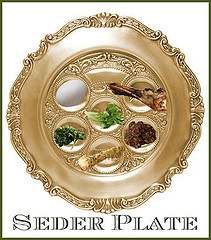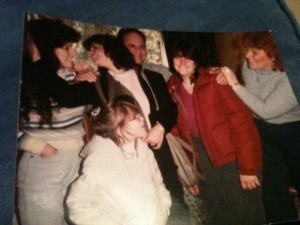The Jewish holiday of Passover begins at sundown this coming Friday April 6th and lasts until April 14th. During that period, families world wide will celebrate a time of freedom and renewal, of Spring cleaning both internally and externally. It commemorates the Exodus of the Jews from Egypt as they escaped slavery. Think of the Charleton Heston classic The Ten Commandments. In the home of my childhood, it meant taking the special dishes from the attic, packing up the every day dishes into the boxes from whence the first group came; it meant clearing the fridge and cabinets of any food that wasn’t marked “Kosher for Passover” and giving it to our Christian next door neighbors and then re-filling the empty spaces that had been swept clean of ‘chametz‘…anything leavened or otherwise not permitted on Passover.
It heralded a time of preparation of all manner of delicacies, such as my mom’s oh so awesome matzah ball soup (she and my Uncle Jim would playfully argue over whether the matzah balls should be light and fluffy…her preference or heavy and dense…his choice:) and my dad’s fried matzah for breakfast. It was the only time of year when we would use sugar cubes in tea…not sure why.
Our festive seder table would be a gathering place for family and friends of various faiths and the Maxwell House Haggadahs would sit at each place setting. We would take turns reading portions from it as we would go around the table. My sister Jan and I would joke about it being “Speed Seder” since my father Moish would run through it quickly…as he did most things. A far cry from the more traditional version that can take hours to complete. In retrospect, I appreciate my father’s brevity. Laughter and lively conversation danced about the dining room table after the more formal part of the dinner was complete.
What I love most about Passover is the symbolic nature of the rituals. The seder plate is a canvas for the artistry of the holiday. It contains
Vegetable (Karpas) – This part of the seder plate dates back to a first and second century tradition in Jerusalem that involved beginning a formal meal by dipping vegetables in salt water before eating them. Hence, at the beginning of the seder a vegetable – usually lettuce, cucumber, radish or parsley – is dipped in salt water and eaten. It is sometimes said that the salt water represents the tears our ancestors shed during their years of enslavement.
Shank bone (Zeroa) / Roasted Beet – The roasted shank bone of a lamb reminds us of the tenth plague in Egypt, when all firstborn Egyptians were killed. The Israelites marked the doorposts of their homes with the blood of a lamb as a signal that death should pass over them, as it is written in Exodus 12:12: “On that same night I will pass through Egypt and strike down every firstborn – both men and animals – and I will bring judgment on all the gods of Egypt… The blood will be a sign… on the houses where you are; and when I see the blood, I will pass over you. No destructive plague will touch you when I strike Egypt.” The shank bone is sometimes called the Paschal lamb, with “paschal” meaning “He [God] skipped over” the houses of Israel.
The shank bone also reminds us of the sacrificial lamb that was killed and eaten during the days when the Temple stood. In modern times, some Jews will use a poultry neck instead. Vegetarians will often replace the shank bone with a roasted beet, which has the color of blood and is shaped like a bone, but is not derived from an animal.
Hard Boiled Egg (Baytzah) – There are two interpretations of the symbolism of the hard boiled egg. One is that it is an ancient fertility symbol. The other is that it is a symbol of mourning for the loss of the two Temples, the first of which was destroyed by the Babylonians in 586 B.C.E. and the second of which was destroyed by the Romans in 70 C.E. Hard boiled eggs were traditionally the food of mourners and hence they were an appropriate symbol for the loss of these sacred sites.
Charoset – Haroset is a mixture that is often made of apples, nuts, wine and spices in the Ashkenazi tradition. It represents the mortar the Israelites were forced to use while they built structures for their Egyptian taskmasters.
Bitter Herbs (Maror) – Because the Israelites were slaves in Egypt we eat bitter herbs to remind us of the harshness of servitude. Horseradish – either the root or a prepared paste – is most often used. A small amount of maror is usually eaten with an equal portion of charoset. It can also be made into a “Hillel Sandwich,” where maror and charoset are sandwiched between two pieces of matzah.
Bitter Vegetable (Hazeret) – This piece of the seder plate also symbolizes the bitterness of slavery. Romaine lettuce is usually used, which doesn’t seem very bitter but the plant has bitter tasting roots. When hazeret is not represented on the seder plate some Jews will put a small bowl of salt water in its place.
Orange – Also optional. The orange is a recent addition to the seder plate and not one that is used in every Jewish home. It was introduced by Susannah Heschel, a Jewish feminist and scholar, as a symbol that represents including women and homosexuals in Jewish tradition – both groups that have often been marginalized. You can learn more about the development of this symbol in this article on the University of Pennsylvania’s website.
Source: judaism.about.com/od/holidays/a/sederplatesymbols.htm
My favorite job in the meal preparation was the charoset, for which I would chop the apples and nuts and swirl in the sweet honey. As a budding feminist, I brought the orange concept to our seders and my parents welcomed the addition.
One of the concepts of the seder is acknowledging the Ten Plagues that were cast upon the Egytptians when Pharoah wouldn’t heed Moses’ proclamation “Let My People Go”. They include: blood, frogs, lice, boils, hail and darkness and the ultimate plague of the slaying of the first born of the Egyptian families. There are those who say that there are ‘natural occurences’ which coincide with each one.
These days I have been questioning the constraints that I have put on myself which I could easily think of as plagues. I willingly face them as I call them out (both verbally and in the dark alley where they have been lurking), so they can see the light of day and I can find my own freedom.
1. Fear of emotional risks
2. Self limiting thoughts
3. Focus on ‘what if?’ and ‘if only?’
4. Judgement/harsh criticism of myself and others
5. Avoidance/denial
6. Neglecting my health
7. Clutter in my environment and my head
8. Comparison of myself and my accomplishments with those of others
9. Co-dependent caregiving/savior behavior and enabling
10. Excessive activity/buzzy-busy-ness
Wishing you all freedom! Chag Sameach (Joyous Festival)
http://youtu.be/awl1KCo_oZ0 The Passover Symbols Song


